Tulbaghia pretoriensis
Tulbaghia pretoriensis Vosa & Condy
Family: Amaryllidaceae
Common names: Pretoria wild garlic (Eng.); Pretoria-wildeknoffel (Afr.)
Introduction
A little-known and recently described species of wild garlic endemic to Pretoria with sweetly fragrant coconut-scented flowers that is low maintenance and a sure stunner for pot plants.
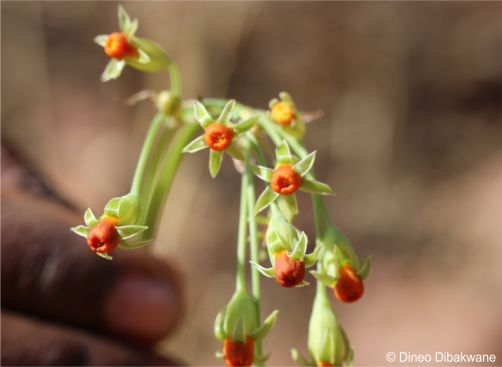
Description
Description
Tulbaghia pretoriensis is a slender, erect, solitary, deciduous perennial with a pear-shaped, bulb-like rootstock that grows between 20-30 mm in diameter. It does not produce a lot of roots and they are somewhat fleshy. The leaves are slightly keeled and grow between 100-300 mm long and 5-7 mm wide and have a short sharp point at the tip. The scape (inflorescence stalk) is long and thin, growing up to 150–200 mm long, and is crowned by a flowerhead that consists of 5-15 flowers. The flowers are held horizontally during flowering and are eventually nodding. The pedicels (flower stalks) range between 15-25 mm long, the first flower that opens is usually on the longest stalk. The spathe valve is sharply pointed and dry during flowering. The flowers are dark green, 7-10 mm long and 2 mm wide, trumpet-shaped, with recurved tepals in two whorls, the upper very near the rim. The corona is a fleshy ring, about one third the total length of the flower, that varies in colour from deep orange to brick red or dark chestnut. In the evening and at night, the flowers emit a potent scent similar to ripe coconuts. Fruit is a 3-lobed ovoid capsule, 12-13 mm long, held vertically on elongated pedicels.
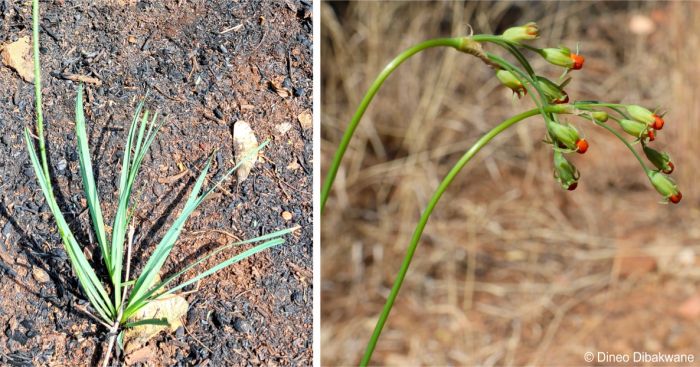
This species looks similar to Tulbaghia acutiloba however they are significantly different when examined closely. T. acutiloba has a smaller fleshy ring compared to that of T. pretoriensis, and the flowers emit a more pungent smell compared to the sweet and rather mild scent of T. pretoriensis. Also, T. pretoriensis has larger rhizomes and wider and shorter flowers compared to those of T. acutiloba. The two species also grow together but differ genetically, with T. pretoriensis being more closely related to T. transvaalensis found in Limpopo and T. macrocarpa in Zimbabwe.
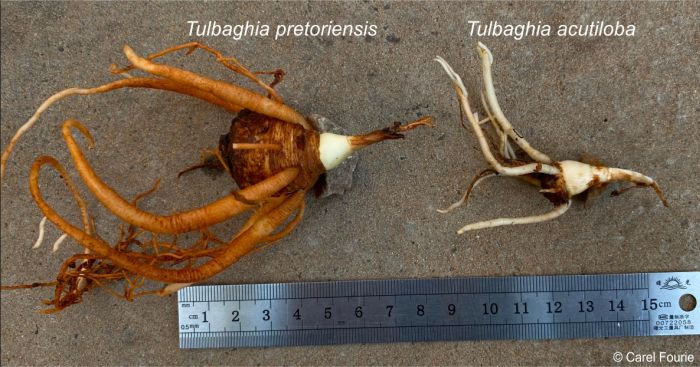
Conservation Status
Status
According to the Red List of South African plants, the conservation status of Tulbaghia pretoriensis is Data Deficient - Taxonomically Problematic (DDT), meaning that this species has taxonomic problems that prohibits the distribution range and habitat from being well defined, so that it can be properly assessed for risk of extinction.
Distribution and habitat
Distribution description
Tulbaghia pretoriensis is only found in Gauteng province. So far the only known sites are in and around Pretoria. It is possible that its distribution may extend further in some neighbouring areas, but due to urbanization in Gauteng, discovering new sites may be difficult. Since the distribution range and habitat are not well defined, more specimensof this species need to be found and studied. In one published article by Canio Giuseppe Vosa and Gillian Condy, they mention that this species is seen growing together with T. acutiloba, which naturally occurs in dry rocky grasslands, up to 1 800 m altitude in the summer rainfall regions of southern Africa. Tulbaghia pretoriensis is only known to occur in the Magaliesberg Mountain region, of which the highest point reaches about 1 852 m above sea level.
Some of the Tulbaghia herbarium specimens, which were unidentified and labelled “near T. acutiloba”, were found to be this new species. Letty, in Wild Flowers of the Transvaal published in 1962, even depicted and discussed T. pretoriensis as T. acutiloba, and in some herbaria, it is also frequently misidentified as T. alliaceae. It may be that there are many specimens of T. pretoriensis that have been overlooked or misidentified.
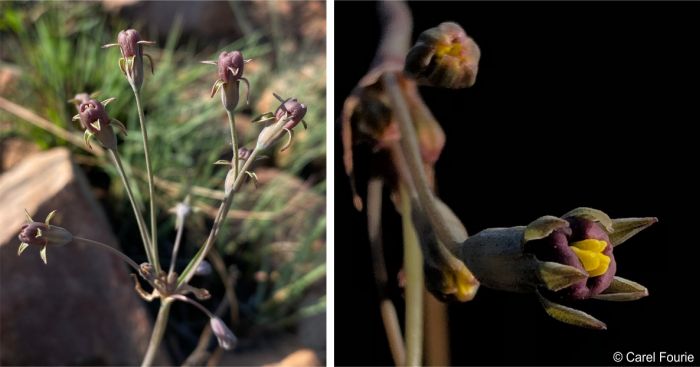
Derivation of name and historical aspects
History
Linnaeus named the genus Tulbaghia after Rijk Tulbagh, who was the Governor of the Cape Colony from 1751 to 71. Rijk was born in Holland in 1699, enlisted with the Dutch East India Company and sailed to South Africa in 1716 and died in Cape Town in 1771. He corresponded with Linnaeus over a long period, and sent him more than 200 plant specimens. This genus was first described from material sent by Tulbagh in 1769. This species is named after Pretoria, a city in the Gauteng province, where most of the herbarium specimens were collected.
The genus Tulbaghia is only found in tropical and southern Africa. It consists of 28 accepted species. The best known ornamental species are T. violacea and T. simmleri. T. pretoriensis is the only one with taxonomic issues because it has been less studied.
This species was described by Vosa and Condy in 2006. The senior author, Vosa, came to the understanding that it was indeed a distinct species after he had already gathered some flowering Tulbaghia plants at the Monument Park grounds in Pretoria in September 1969, during the Oxford Botanical Expedition to eastern and southern Africa. At the time, these plants were thought to be similar to T. acutiloba. The plants he collected were grown in a temperate greenhouse in Europe where they flourished and blossomed. It immediately became apparent to him that these plants differed from T. acutiloba in some key details. He conducted a thorough examination of several herbarium specimens in the National Herbarium that were all obtained in and around Pretoria. What settled the issue was their chromosomal complement that indicated that their cytotaxonomic status differed from that of T. acutiloba. The type specimen chosen was the specimen collected by Gillian Condy, 24, in the National Herbarium, Pretoria, that was initially identified as T. acutiloba but accurately reflects the new species T. pretoriensis. The plate used as the iconotype for T. pretoriensis was that painted by Condy and published as T. acutiloba in 2001, in Flowering Plants of Africa, Plate 2164, which is based on the same specimen as the typus.
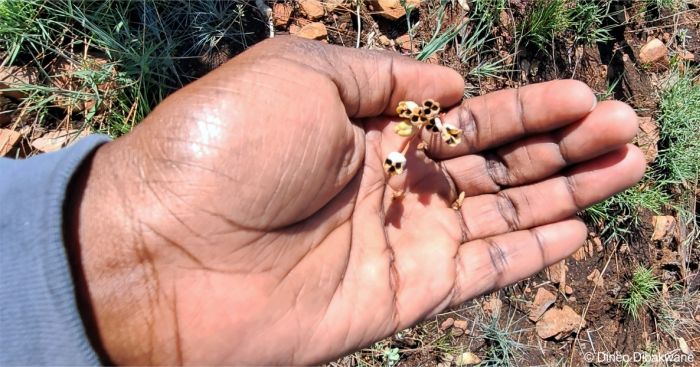
Ecology
Ecology
Tulbaghia pretoriensis flowers are likely to attract moths, or other night-flying insects, becausethey emit their sweet scented in the evening and at night. The plants go dormant in winter, the leaves die back and resprout again in spring.
Uses
Use
There is no literature to prove medicinal uses of this species. Since it grows together with T. acutiloba in Gauteng, it is possible that it has similar medicinal and culinary uses as T. acutiloba.
Growing Tulbaghia pretoriensis
Grow
Tulbaghia acutiloba is one of the easiest plants to propagate and we would treat T. pretoriensis similarly. Even though they are solitary in the wild, they do form clumps after many years in cultivation. T. pretoriensis can be propagated by lifting and splitting the clumps and through seeds. Leave a clump undisturbed for at least 5 years, or until they are flowering less, before lifting and dividing it. Replant immediately after lifting. Sow seed in spring or early summer. Seed germinates in 2–3 weeks and seed-grown plants should flower in their third year.
Grow in well-drained loam soil enriched with humus and water in summer. Even though it is drought tolerant, it requires minimal watering during summer once established. It is frost tolerant, ideal for grassland and Highveld gardens with a dry winter rest period. Best planted in a sunny position among low-growing grasses or in a rockery. It also makes a showy pot plant.
References
- Ndlovu, B. & Notten, A. 2019. Tulbaghia acutiloba Harv. PlantZAfrica. Online. https://pza.sanbi.org/tulbaghia-acutiloba.
- Plants of the World Online. Tulbaghia L. https://powo.science.kew.org/taxon/urn:lsid:ipni.org:names:331301-2. Accessed on 2024-08-20.
- Raimondo, D., Von Staden, L., Foden, W., Victor, J.E., Helme, N.A., Turner, R.C., Kamundi, D.A. & Manyama, P.A. (eds) 2009. Red list of South African plants. Strelitzia 25. South African National Biodiversity Institute, Pretoria.
- Vosa, C.G. & Condy, G. 2006. Tulbaghia pretoriensis, a new species from the Province of Gauteng (South Africa). Caryologia 59(2): 164-167.
Credits
Dineo Dibakwane, Linda Booysen and Lethabo Leponisa
Walter Sisulu National Botanical Garden
September 2024
Acknowledgements: the authors thank Carel Fourie for providing images.
Plant Attributes:
Plant Type: Bulb
SA Distribution: Gauteng
Soil type: Sandy, Loam
Flowering season: Spring, Early Summer
PH:
Flower colour: Brown, Green, Orange
Aspect: Full Sun
Gardening skill: Easy
Special Features:
Horticultural zones
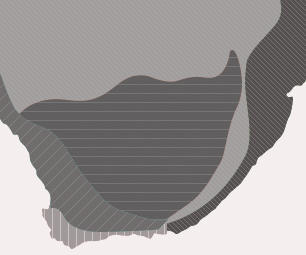







Rate this article
Article well written and informative
Rate this plant
Is this an interesting plant?
Login to add your Comment
Back to topNot registered yet? Click here to register.